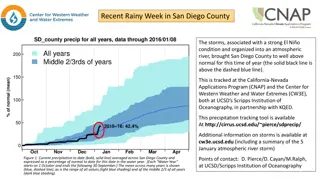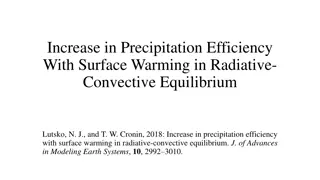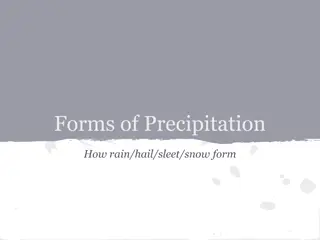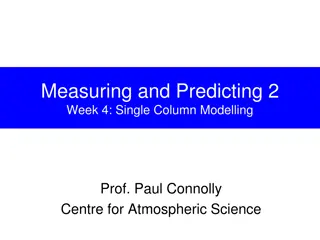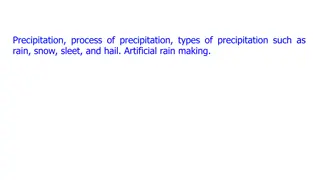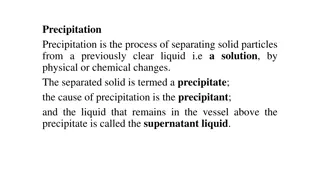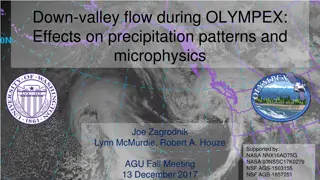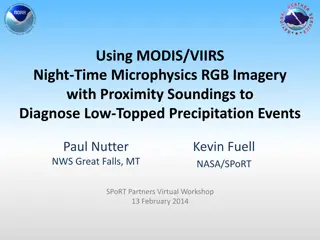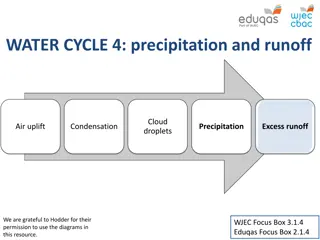Understanding Precipitation: Forms and Types Explained
Precipitation, any form of moisture reaching Earth's surface from the atmosphere, encompasses various types like rain, snow, drizzle, glaze, sleet, and hail. Each type has unique characteristics, densities, and formation processes. Additionally, precipitation can be classified into convection, cyclonic, and orographic types based on its origin and cause. Learning about the different forms and types of precipitation is crucial for understanding weather patterns and their impact on the environment.
Download Presentation

Please find below an Image/Link to download the presentation.
The content on the website is provided AS IS for your information and personal use only. It may not be sold, licensed, or shared on other websites without obtaining consent from the author. Download presentation by click this link. If you encounter any issues during the download, it is possible that the publisher has removed the file from their server.
E N D
Presentation Transcript
Module: 1 Precipitation Subject Hydrology & Irrigation Engg Subject Code 15CV73 Name of the Faculty SHASHI PRASAD N Dept. of Civil Engg K S SCHOOL OF ENGG & Management
PRECIPITATION PRECIPITATION It is defined as any form of moisture reaching the earth s surface from the atmosphere
FORMS OF PRECIPITATION The various forms of precipitation are: 1. Rain: It describe the precipitation in the form 0f water droplets of sizes larger than 0.5mm. 2. The maximum size of the rain drop is 6mm is used to
FORMS OF PRECIPITATION 2. Snow: It consist of ice crystals which is usually combine to form flakes. Its initial density varies from 0.06 to 0.15 kg/cm3 The average density is about 0.1 g/cm3
FORMS OF PRECIPITATION Drizzle: it is a fine sprinkle of numerous water droplets of size less than 0.5mm. Its intensity is less than 1mm/hr. The drops are so small that they appear to float in the air
FORMS OF PRECIPITATION Glaze: when rain or drizzle comes in contact with cold ground at around 0 degree Celsius, the water drops freeze to form an ice coating
FORMS OF PRECIPITATION Sleet: it is an frozen rain drops of transparent grains which form when rainfalls through air at sub freezing temperature
FORMS OF PRECIPITATION Hail: it forms in the form of irregular pellets or lumps of size more than 8mm. This usually occur in violent thunderstorms in which vertical currents are strong
TYPES OF PRECIPITATION Convection precipitation Cyclonic precipitation Orographic precipitation
TYPES OF PRECIPITATION 1. Cyclonic Precipitation: It is a large low pressure region with circular wind motion. There are two types in cyclonic precipitation: Tropical Cyclones 2. Extra-Tropical Cyclones 1.
TROPICAL CYCLONES It is a wind system with an intensely strong depression with MSL pressures, sometimes below 915m bars. The normal area extent of a cyclone is about 100-200 Km in diameter. The isobars are closely spaced and the winds are in anticlockwise in the northern hemisphere
TROPICAL CYCLONES The centre of the storm is called eye which can extend about 10-50km in diameter. The wind speed gradually decreases towards the outer edge. The right outside the eye, very strong winds/reaching as much as 200kmph The pressure also increases outwards.
TROPICAL CYCLONES The centre of the storm is called eye which can extend about 10-50km in diameter. The wind speed gradually decreases towards the outer edge. The right outside the eye, very strong winds/reaching as much as 200kmph The pressure also increases outwards.
TROPICAL CYCLONES rainfall will normally be heavy in entire area occupied by the cyclone. This cyclone causes heavy damage to the life and property on their land path and intense rainfall and heavy floods in the streams are its usual consequences The
EXTRA-TROPICAL CYCLONE These are formed in location outside the tropical zone. They posses a strong counter clockwise wind circulation in the northern hemisphere. The magnitude of precipitation and wind velocities are relatively lower than these of a tropical cyclones The duration of this type is usually longer and the area extent also is larger
CONVECTIVE PRECIPITATION A packet of air which is warmer than the surrounding air due to the localized heating rises because of its lesser density. Air from the cooler surroundings flows to take up its place thus setting up a convective cell. The warmer air continues to rise, undergoes cooling and resulting in precipitation The area extent off such rains is small being limited to a diameter of about 10km.
OROGRAPHIC PRECIPITATION The moist air masses get lifted up to higher altitudes due to the presence of mountains barriers and consequently undergo cooling, condensation and precipitation. In the mountain ranges, the windward slopes have heavy precipitation and the lee ward slopes light rainfall
SYMONS RAIN GUAGES It is the non-recording rain guages. It essential consists of a circular collecting area of 12.7 cm in diameter connected to the funnel. The rim of the collector is set in a horizontal plane at a height of 30.5cm above the ground level.
SYMONS RAIN GUAGES The funnel discharges the rainfall, catch into receiving vessel. The funnel and the receiving vessels are housed in a metallic container. Water contained in the receiving vessel is measured by a suitably graduated measuring glass with an accuracy up to 0.1mm. a
SYMONS RAIN GUAGES The rainfall is measured everyday at 8.30 am and is recorded as the rainfall in a day. The receiving bottle normally does not hold more than 10cm of the rain. Proper care must be taken in maintenance and inspections of the rainguages.
SYPHONS RAINGUAGES This is the recording type of rain guages. It is also called as float type rain guages. It uses the siphon mechanism to empty the rain water collected in the float chamber. Rain water entering the guage at the top is led into the float chamber through a funnel and filter
SYPHONS RAINGUAGES The filter is provided to prevent the dust and other particles . The float chart consist of the float with a vertical stem protruding outside to the top of which pen is mounted. This pen rest on a chart secured around a clock driven drum.
SYPHONS RAINGUAGES There is a small compartment by the side of the float chamber which is connected to the float chamber through a small opening at the bottom. This is called as siphon chamber which houses the small vertical pipe. This pipe with the bottom end open and the top end almost touching the top of the chamber.
SYPHONS RAINGUAGES During the rain water is collected in the float chamber raises the water surface in it and along with the water surface the float also rises enabling the pen to a make a trace of cumulative depth of rainfall on the chart
https://www.youtube.com/watch?v=m_ALjsA1Als https://www.youtube.com/watch?v=PbdNB6XlQKc
OPTIMUM NUMBER OF RAIN- GUAGE STATIONS The selected area of a rain guage is very small compared to the areal extent of a storm. To get representative of rain over a catchment area the number of rain- guages should be large as possible. a actual
OPTIMUM NUMBER OF RAIN- GUAGE STATIONS The world meteorological organization recommends the following densities In Flat regions of temperate, Mediterranean and tropical zones: 1. Ideal 1 station for 600-900 km2. 2. Acceptable: 1 station for 900-3000 km2 In mountain region of temperate, Mediterranean and tropical zones: 1. Ideal 1 station for 100-250 km2. 2. Acceptable: 1 station for 250-1000 km2 In arid and polar zones 1 station for 1500-10000 km2 depending upon the feasibility.
OPTIMUM NUMBER OF RAIN- GUAGE STATIONS From practical considerations of Indian conditions, the Indian Standards recommends the following densities as sufficient In Plains 1 station for 520km2. In region of average elevation of 1000m 1 station per 260-390 km2. In predominantly hilly areas with heavy rainfall- 1 station per 130km2
CONSISTENCY OF RAINFALL DATA It is a technique for checking for inconsistency of a record. The causes for the inconsistency of a record is due to: 1. Shifting of a rain-guage to a new location. 2. The neighbour-hood of the station undergoing a marked change. 3. Change in ecosystem due to calamities such as landslides etc. 4. Occurrence of observational error from a certain data
DOUBLE MASS CURVE A group of 5 to 10 base stations in the neighbour-hood of the problem X station is selected. The data of the annual rainfall of the station X and also the average rainfall of the group of the base station covering for a long period is arranged in the reverse chronological order. The accumulated precipitation of the station Px and the accumulated values of the average of the group of base station Pav is calculated starting from the latest record.
DOUBLE MASS CURVE Values of Px are plotted against Pav for the various consecutive time periods. A decided break in the slope of the resulting plot indicates a change in precipitation regime of a station X . The precipitation values at station X beyond the period of change of regime is corrected by using relation Pxc =Px * (Me/Ma) the
COMPUTATION OF MEAN RAINFALL There are three methods to calculate the mean rainfall. They are: 1. Arithmetical Mean Method. 2. Thiessen- Mean Method. 3. Isohyetal Method.
Arithmetical Mean Method. When measured stations in a catchment show little variation, the average precipitation over the catchment area is taken as arithmetical Mean Method.. the rainfall various at
THIESSEN MEAN METHOD In this method the rainfall recorded at each station is given a weightage on the basis of an area closet to the station.
ISOHYETAL METHOD It is the line joining points of equal rainfall magnitude.
PRESENTATION OF PRECIPITATION DATA MOVING AVERAGE CURVE It is a technique for smoothening out the high frequency fluctuations of a time series and to enable the trends, if any noticed. This technique can be applied to other hydrological parameters such as temperature, wind etc.
PRESENTATION OF PRECIPITATION DATA MASS CURVE It is a plot of the accumulated precipitation against the time plotted in chronological order. Records obtained from the float type and weighing bucket type guages are of this form. It is very useful in extracting the information on the duration and magnitude of the storm.
PRESENTATION OF PRECIPITATION DATA HYETOGRAPH It is the plot of the intensity of rainfall against the time interval. It is derived from the mass curve and is usually represented as a bar chart. It represents the total precipitation received in the period. The time intervals depends on the purpose required.







